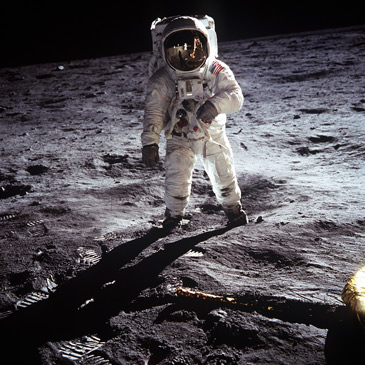Liquid-cooled garments that keep firefighters and racecar drivers from getting too hot. Digital image processing technology used in lifesaving medical and diagnostic tools such as CAT scans and MRIs. A “blow rubber molding” process for space helmets that resulted in a better athletic shoe.
The space-age technology developed by NASA to send humans to the moon and return them safely to Earth accelerated innovations in everything from computers and medicine to electronics and oceanography.
But did the moon landing unite us as a people, if only for a short time? Was the space race really about beating the Russians to the moon? And what of the future—should we really go back and beyond?
Catherine L. Newell, assistant professor of religious studies in the University of Miami College of Arts and Sciences and author of Destined for the Stars: Faith, the Future, and America’s Final Frontier, which explores what drove the U.S. to expand its space exploration endeavors, answers some questions about the historic Apollo 11 mission.
From a technological perspective, the moon landing accelerated all sorts of innovations in rockets, computers, and other space-age materials. But did it unite us, even for a brief moment? Or did it divide us, as some people viewed the mission as a waste of national resources?
The moon landing was a lot of things to a lot of people. On the one hand, the whole concept of a “moonshot”—a technical feat that seemed almost impossible to achieve—came from this seemingly unattainable goal of putting an American on the moon. While scientifically-plausible plans to reach the moon had been circulating since the early 1950s, the U.S. was nowhere near prepared for a program on the scale of Apollo when President Kennedy made his speech to Congress in May 1961, challenging the nation to have a man on the moon by the end of the decade. Not only did the Russians have better rockets at the time, but the extent of the effort was unimaginable in the early 1960s.
That said, the idea was inspiring, and—especially after the Russians launched Sputnik, the world’s first satellite, in 1957—America had been ramping up its emphasis on what today we call STEM (science, technology, engineering, mathematics) education, hoping to train a new generation to build and launch rockets to the moon and beyond. And while there was a great deal of domestic unrest during the 1960s—Vietnam War protests, civil rights demonstrations, women’s movements, and more—and plenty of people thought we should be concentrating on our problems on Earth instead of trying to land on the moon, the Apollo 11 landing was arguably one of the most profound moments of what sociologist of religion Robert Bellah called “American civil religion: a nonsectarian, nondenominational faith that American symbols, rituals, and beliefs are in some way sacred.” And, when it finally happened, even people who thought the effort was a financial drain or an unnecessary military exercise were pretty profoundly moved by Neil Armstrong, Buzz Aldrin and Michael Collins’ journey to and from the moon.

Was the Apollo program really about beating the Russians to the moon?
Historians have argued for a long time that the primary inspiration for the Apollo program was attempting to beat the Russians to the moon. While this was definitely a motivating factor, I think if the moonshot was only about beating the Russians the whole thing might have fizzled in light of domestic political issues in just a few years (after all, our first attempts at launching rockets into space went pretty poorly). For me—and other scholars—a hugely important element of getting to the moon was that it was an exercise in the aforementioned civil religion; lots of people (not just Americans) saw getting to the moon as the fulfillment of our God-given destiny, the first step in getting off Earth and to other planets in our solar system. [I talk about this in my book, Destined for the Stars: Faith, the Future, and the Final American Frontier.] Some of those people thought we were destined to explore the cosmos, but others thought that we—all humans—were on a collision course with disaster due to the proliferation of atomic weapons, overpopulation, resource depletion, species extinction, etc. So, the folks in the latter group thought that rockets might literally be a miraculous way to save humanity. And, if that idea sounds a little weird, read what people like Elon Musk and Jeff Bezos say about why they’re building rockets and supporting manned missions to Mars today.
What are your thoughts on our planned return to the moon by 2024 and the goal of sending humans to Mars?
While I personally am delighted with the prospect of ongoing exploration of and scientific discovery on the moon, Mars, Titan, etc., I think we need to travel to those places purely for the sake of knowledge, not as a dry run for evacuating the Earth. For a long time everywhere from near-Earth orbit to the moons of Saturn have felt like a potential escape route from Earth—someplace we can go when we really mess things up at home. Because one thing the Apollo program showed the world was the huge technological and financial effort it took to get just three guys to the moon and back, which meant that rockets were not going to be a feasible or reliable way to get people off-planet anytime soon.
But one of the best parts of the Apollo program, which is sometimes forgotten, is the way that the images of Earth were incorporated into the fledgling environmental movement in the late 1960s/early 1970s; astronauts and scientists and environmentalists all used the pictures of our planet taken on route to the moon to make the point that the Earth is both unique and precious. From the perspective of the Apollo spacecraft, the Earth was small, bright blue, and just floating all by itself in an absolutely enormous void. Almost every astronaut who went to the moon came back having experienced a profound change in their attitude toward life on Earth in general and humanity in particular; several described it as a religious experience, and nearly all of them have tried to help the rest of humanity understand just how special our planet is. And while returning to the moon and trying to reach Mars are an exciting extension of the Apollo program’s history, I think what might be the most moving legacy of the moon landing is how it ultimately showed us Earthlings how fragile and beautiful our home is, and that we should do whatever it takes to save it.

